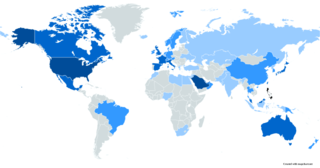
Rural flight is the migratory pattern of people from rural areas into urban areas. It is urbanization seen from the rural perspective.

Human capital flight is the emigration or immigration of individuals who have received advanced training at home. The net benefits of human capital flight for the receiving country are sometimes referred to as a "brain gain" whereas the net costs for the sending country are sometimes referred to as a "brain drain". In occupations with a surplus of graduates, immigration of foreign-trained professionals can aggravate the underemployment of domestic graduates, whereas emigration from an area with a surplus of trained people leads to better opportunities for those remaining. But emigration may cause problems for the home country if the trained people are in short supply there.

Human migration is the movement of people from one place to another with intentions of settling, permanently or temporarily, at a new location.

Foreign workers or guest workers are people who work in a country other than one of which they are a citizen. Some foreign workers use a guest worker program in a country with more preferred job prospects than in their home country. Guest workers are often either sent or invited to work outside their home country or have acquired a job before leaving their home country, whereas migrant workers often leave their home country without a specific job in prospect.

A migrant worker is a person who migrates within a home country or outside it to pursue work. Migrant workers usually do not have the intention to stay permanently in the country or region in which they work.

An overseas Filipino is a person of full or partial Filipino origin—i.e., people who trace back their ancestry to the Philippines but living or residing outside the country. This term generally applies to both people of Filipino ancestry and citizens abroad. As of 2019, there were over 12 million Filipinos overseas.
Geographic mobility is the measure of how populations and goods move over time. Geographic mobility, population mobility, or more simply mobility is also a statistic that measures migration within a population. Commonly used in demography and human geography, it may also be used to describe the movement of animals between populations. These moves can be as large scale as international migrations or as small as regional commuting arrangements. Geographic mobility has a large impact on many sociological factors in a community and is a current topic of academic research. It varies between different regions depending on both formal policies and established social norms, and has different effects and responses in different societies. Population mobility has implications ranging from administrative changes in government and impacts on local economic growth to housing markets and demand for regional services.
Mixtec transnational migration is the phenomenon whereby Mixtec people have migrated between Mexico and the United States, for over three generations.

Overseas Filipino Worker (OFW) is a term often used to refer to Filipino migrant workers, people with Filipino citizenship who reside in another country for a limited period of employment. The number of these workers was roughly 1.77 million between April and September 2020. Of these, female workers comprised a larger portion, making up 59.6 percent, or 1.06 million. However, this number declined to 405.62 thousand between 2019 and 2020.

Immigration is the international movement of people to a destination country of which they are not natives or where they do not possess citizenship in order to settle as permanent residents or naturalized citizens. Commuters, tourists, and other short-term stays in a destination country do not fall under the definition of immigration or migration; seasonal labour immigration is sometimes included, however.
The economic results of migration impact the economies of both the sending and receiving countries.
International migration occurs when people cross state boundaries and stay in the host state for some minimum length of the time. Migration occurs for many reasons. Many people leave their home countries in order to look for economic opportunities in another country. Others migrate to be with family members who have migrated or because of political conditions in their countries. Education is another reason for international migration, as students pursue their studies abroad, although this migration is sometimes temporary, with a return to the home country after the studies are completed.
Internal migration in the People's Republic of China is one of the most extensive in the world according to the International Labour Organization. This is because migrants in China are commonly members of a floating population, which refers primarily to migrants in China without local household registration status through the Chinese Hukou system. In general, rural-urban migrant most excluded from local educational resources, citywide social welfare programs and many jobs because of their lack of hukou status. Migrant workers are not necessarily rural workers; they can simply be people living in urban areas with rural household registration.
Brain circulation is the circular movement of skilled labour across nations.
In anthropology, cultural remittances are the ensembles of ideas, values, and expressive forms introduced into societies of origin by emigrants and their families as they return home, sometimes for the first time, temporary visits, or permanent resettlement. The term, which has been summarized as "product sent back", developed in the early 2000s, is also used to describe "the way that migrants own and build homes in the country of origin."
The labor migration policy of the Philippine government allows and encourages emigration. The Department of Foreign Affairs, which is one of the government's arms of emigration, grants Filipinos passports that allow entry to foreign countries. In 1952, the Philippine government formed the Philippine Overseas Employment Administration (POEA) as the agency responsible for opening the benefits of the overseas employment program. In 1995, it enacted the Migrant Workers and Overseas Filipino Act in order to "institute the policies of overseas employment and establish a higher standard of protection and promotion of the welfare of migrant workers and their families and overseas Filipinos in distress." In 2022, the Department of Migrant Workers was formed, incorporating the POEA with its functions and mandate becoming the backbone of the new executive department.
Women migrant workers from developing countries engage in paid employment in countries where they are not citizens. While women have traditionally been considered companions to their husbands in the migratory process, most adult migrant women today are employed in their own right. In 2017, of the 168 million migrant workers, over 68 million were women. The increase in proportion of women migrant workers since the early twentieth century is often referred to as the "feminization of migration".

Step migration is a migration pattern conceptualized in 1885 by Ernst Georg Ravenstein who observed migration as occurring stage by stage as rural inhabitants move closer to urban areas of growth. It is a migration pattern regarded by some scholars to be a widely popular form of international migration in the twenty-first century globalized world. There is a large breadth of study proving the existence of step migration in many international migration patterns, although there is lack of consensus over its exact specification and measurement. Step migration scholars deem it to be an important international trend that has the power to aid in the design of policy development efforts in both rural and urban areas worldwide. According to Abrahm Lustgarten, Senior Environmental Reporter for ProPublica, in his May 2021 report, Step migration -- or "stepwise migration" -- is a characteristic migration pattern of\\driven by climate change.
A global care chain is a globalized labor market for workers who provide care-intensive labor, such as childcare, eldercare and healthcare. The term was coined by the feminist sociologist Arlie Hochschild. The movement of these workers is an important topic for research and policy development since the number of international migrants around the world has grown substantially since the 1990s.
Almost half of international migrants are women, generally travelling as either migrant workers or refugees. Women migrant workers migrate from developing countries to high-income countries to engage in paid employment, typically in gendered professions such as domestic work. Because their work disproportionately takes place in private homes, they are vulnerable to exploitation and abuse. Wages earned are largely sent home to the originating country to support the cost of living of the family left behind.












